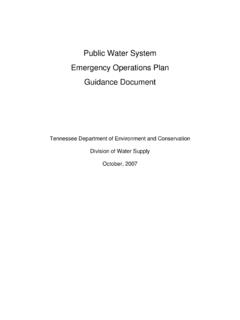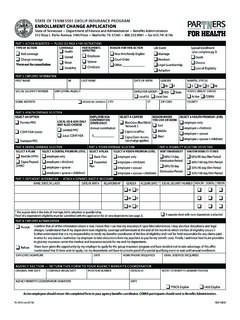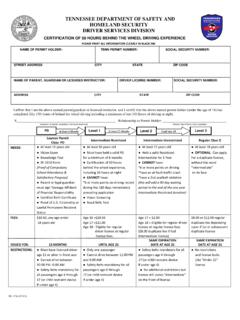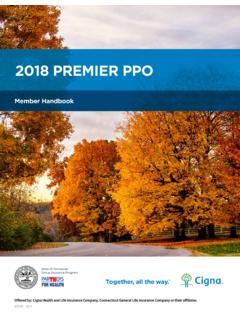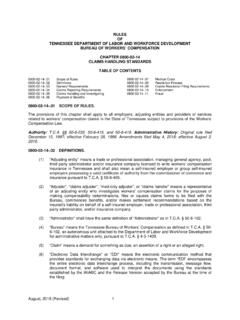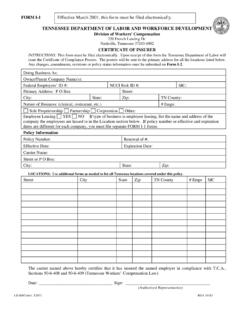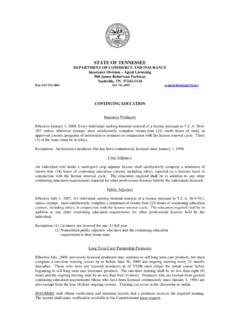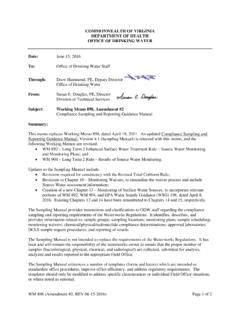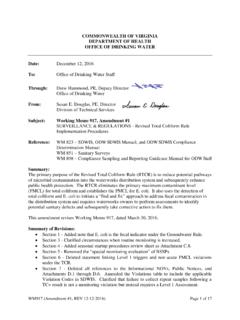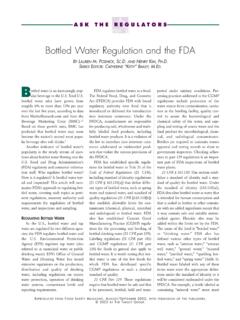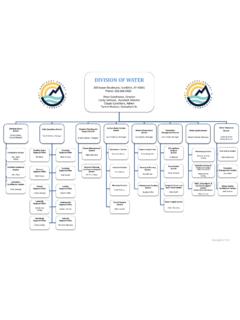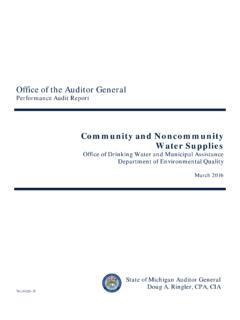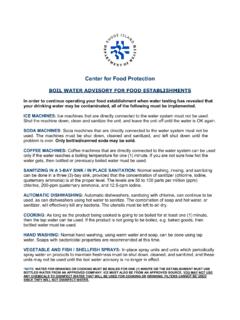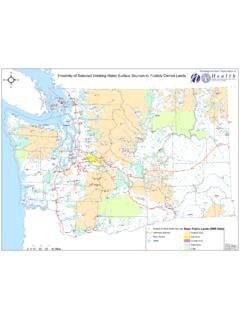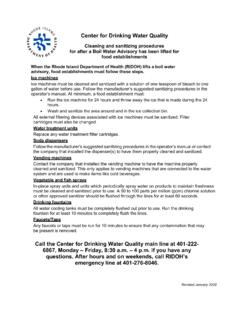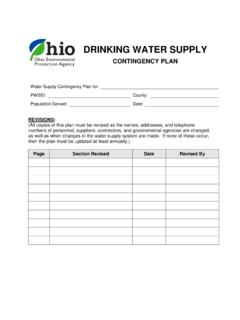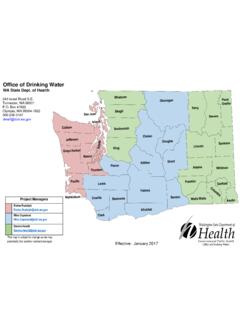Transcription of Tennessee Healthy Well Manual - tn.gov
1 Tennessee Healthy Well Manual September 2015 Revision Healthy WELL Manual Steps You Should Take to Protect Your Well or Spring Many Tennesseans still rely on private wells and springs. The first line of defense for these wells and springs is the homeowner - the state does not periodically test private wells or springs as it would be a monumental and extremely costly task. Wells can become contaminated through improper construction, maintenance or poor housekeeping practices around the well. Springs are particularly vulnerable to contamination. There are certain steps you can take to ensure you have a Healthy well and safe drinking water . Things that you can do to protect the well or spring include, but are not limited to: 1. Don t store chemicals dangerous to water supplies near the well or spring or allow any to be poured out near the well or spring. Such chemicals would include gasoline, fertilizers, pesticides and solvents.
2 2. Be sure your well casing extends high enough above ground to prevent surface water from entering your well. The well casing should extend 24 inches above the level of the 100 year flood level of record. There should be a positive sealing of the annulus between the borehole and the outside of the well casing to prevent seepage of surface water vertically along the outside pipe into the well. Grouting will provide positive sealing of the space between the borehole and the outside of the well casing. Slabs of concrete poured around the top of the well casing will also help to protect the well. All wells should have a sanitary seal or cap to prevent insects or animals from entering the well. Pitless adapters should be used with submergible pumps. Be sure that your spring has a spring box that is designed to keep out animals, insects and surface water . 3. Don t drill wells near obvious sources of contamination such as septic tanks or field lines, animal feed lots, chicken houses, etc.
3 The following distances of separation are required by regulation: Potential Sources of Contamination Minimum Distances Sewage Lagoons; Leaching Pits 200 feet Animal Pens; Feed Lots 100 feet Sludge; Septage Disposal Sites 100 feet Pit Privies 75 feet Sewer Lines 50 feet Septic Tanks; Drain Fields 50 feet House To Septic Tank Connections (Tightline) 10 feet 4. Don t allow anything to be dumped in nearby sinkholes. 5. Properly plug and abandon any abandoned wells on your property and encourage adjacent property owners to do the same. Sinkholes and abandoned wells provide a direct conduit for contaminants into the ground water . 6. Fence animals away from your well casing or spring. Cattle should be kept at least 100 feet from the well. 7. Landscape or trench surface water away from well casing and springs to prevent surface water entry into the well or spring. 8. Install a filtration system installed to protect you from the harmful bacteria and other pathogens common to surface water if your well or spring muddies up after a rain.
4 9. After making repairs to pipes and pumps be sure that the pumps or pipes are disinfected before being placed back into use. Bacteria can enter a well from the handling of the pump and pipe as well as from the drilling equipment. A strong chlorine solution will kill most bacteria in a well if allowed to remain for at least twelve (12) hours. The water Well Construction standards require both the driller and pump installer to disinfect the well. To disinfect the well, pour into the well one (1) gallon of chlorine bleach or one (1) ounce HTH super chlorinated solution for every fifty (50) feet of well depth. Once the chlorine is in the well, the faucets in the home should run until a chlorine odor is noticed. The water is then turned off and allowed to remain in the well and pipes for at least twelve (12) hours. After twelve (12) hours, the water should be pumped out of the well until the chlorine odor is gone.
5 Do not run heavily chlorinated wastewater through a septic tank system or discharge into a surface water body. The disinfection procedure should be repeated each time the well, pump or pipes are serviced. 10. Limit public access to your spring or well to prevent vandalism. 11. Have your well or spring tested every two years for bacteria. If it tests positive, shock chlorinate the well using chlorine bleach and have it re-tested after 2 or 3 weeks (see #9 above). If it tests positive again, a disinfection system needs to be installed (chlorination is the most common but ultraviolet light is also being used). 12. Ensure no chemicals are applied within 100 foot (minimum) of the well or spring through written agreements with other property owners, if necessary. Other pesticide applications can also be a concern, particularly from pest control applicators. There have been documented cases in Tennessee where applicators have accidentally injected pesticides for termites into wells that were cut off below ground.
6 13. Limit the use of onsite septic system to septic waste. Ground water is frequently contaminated with bacteria, viruses, nitrates, detergents, oils, and chemicals by septic systems that are improperly sited, designed or constructed or maintained. Certain Middle Tennessee counties at one time allowed the blasting in of field lines, which is the equivalent of pouring sewage down a well. Commercially available septic system cleaners containing synthetic organic chemicals (such as 1,1,1-trichloroethane or methylene chloride) have contaminated drinking water wells. Many chemicals should not be disposed of in household septic systems, including oils ( , cooking, motor), lawn and garden chemicals, paints and paint thinners, disinfectants, medicines, photographic chemicals, and swimming pool chemicals. These chemicals will kill the bacteria necessary for the breakdown of the septic waste.
7 14. If you are using a hand dug well, you should strongly consider having a chlorinator installed. Hand dug wells are actually a surface water drain rather than an actual ground water draw and are extremely susceptible to contamination. If you are using a spring, you should also consider a treatment system -- springs can be very susceptible to contamination as well. It would actually be best if you were to have a well drilled by a licensed driller using proper construction techniques. Well improvement For help identifying contamination sources and recommending improvements/ treatment for your well, contact drinking water Unit staff within the Division of water Resources at your nearest Department of Environment and Conservation regional office . Central Tennessee (Nashville): (615) 687-7000 Southern Central Tennessee (Columbia): (931) 380-3371 Eastern Central Tennessee (Cookeville): (931) 432-4015 West Tennessee (Jackson): (731) 512-1300 Southeastern Tennessee (Chattanooga): (423) 634-5745 East Tennessee (Knoxville): (865) 594-6035 Northeast Tennessee (Johnson City): (423) 854-5400 If you are calling from the county where your well or spring is located, calling 1-888-891-8332 (1-888-891-TDEC) will automatically route you to the appropriate field office .
8 Well drillers, pump installers and treatment device installers are licensed by the State. Contact the Division of water Resource s Nashville Central office drinking water Unit staff at (615) 532-0191 or 1-800-523-4873 for licensed operators in your area. They can also provide you with a list of certified laboratories for the testing of your well. Well construction and inspection water well staff from the regional field office inspect a percentage of water wells drilled yearly. When having a new well drilled, ask for driller s tag registration number and be sure well log is filed with the state. You may request the field office individually inspect your well. Backfilling of the well should include a drilling mud (bentonite clay) and the well should be drilled with potable water . The driller should also be concerned about leaks and spills from his drill rig in the drilling process. The Division of water Resource s drinking Unit staff should have a copy of your well log on file if drilled since 1967.
9 Reports filed with the state are available from the Division of water Resource, 312 Rosa L. Parks Avenue , 11th Floor, William R. Snodgrass Tennessee Tower in Nashville Tennessee 37243. (615) 532-0191 or 1-800-523-4873. You need to provide homeowners name at time of drilling, approximate location & county, drillers name and/or date drilled is also helpful and Driller tag (if known). Although the type and depth of well construction varies with location, there are several important things to be aware of concerning the construction of a well: The outside diameter of most private, domestic water wells is 6 5/8 inches in Middle and East TN, and 4 inches in West TN. New black or galvanized steel casing is required when drilling and completing a well in bedrock. Most wells in Middle and East Tennessee require steel casing. Wells developed in sand or other loose material may be cased with plastic pipe approved by the National Sanitation Foundation (NSF) with a minimum stress design rating Standard Dimension Ratio (SDR) 26.
10 Watertight casing should extend at least six (6) inches above ground level; a minimum of two (2) feet for areas subject to flooding. Wells constructed in bedrock should have watertight casing down to nineteen (19) feet or five (5) feet into the top of bedrock, whichever is greater. Wells constructed in unconsolidated material such as sand or gravel should have watertight casing down to nineteen (19) feet or to the top of the aquifer, whichever is greater. The well should be sealed at the top of the casing with a suitable cap or sanitary seal. The outside of the well casing should be backfilled with an impervious material such as cement grout or bentonite clay, from a minimum of three (3) feet to ten (10) feet below land surface to prevent surface water from entering the well. The remaining backfill material may consist of bentonite, cement, drill cuttings or a mix of cuttings and bentonite.
